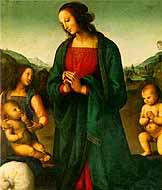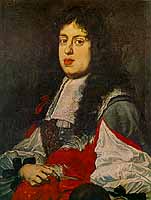
Giusto Sustermans,
portrait of Vittoria della Rovere
The collections of the Medici Grand Dukes were unexpectedly enriched in 1631 by the wedding contract between Ferdinando II (Grand Duke from 1621 to 1670) and Vittoria della Rovere, when some of the most important paintings from the collection of the duchy of Urbino (which had been inherited, as last descendant of the family, by the young Grand Duchess), were brought to Florence: 57 extraordinarily fine works of art carried out by masters like Piero della Francesca (portraits of Federico da Montefeltro and Battista Sforza), Raphael (portraits of Francesco Maria della Rovere and Pope Julius II) and Titian (Bella, Venus of Urbino, Portrait of Eleonora Gonzaga and Francesco Maria della Rovere). The year 1639 also saw the arrival in Florence of the Assumption by Andrea del Sarto, donated to Grand Duke Ferdinando II by the nobleman Passerini da Cortona, and the Rest in Egypt by Correggio, obtained from the Duke of Modena in exchange for another painting (Sacrifice of Isaac by Andrea del Sarto).

Giusto Sustermans,
portrait of Ferdinando
The 17th century was a golden century for the Medici collections because
several members of the cadet family made important contributions to it,
like the Cardinal Dean Carlo (1596-1666, fifth of Ferdinando
I's eight children), who collected over 176 paintings in his residence
in Piazza San Marco, many of them of
contemporary Tuscan school, and Ferdinando
II's three brothers: Giovan Carlo (1611-63), who had a preference
for Salvator Rosa and Van Aelst, Mattias (1613-67), who bought the St.
Francis by Ribera but really preferred battle scenes by Borgognone and
Livio Mehus, and Cardinal Leopoldo (1617-75).
The latter, in particular, collected an incredible number of paintings
from all over Italy, especially from the Venetian school (including four
paintings by Titian: Portrait of Vincenzo Mosti, Concert, previously attributed
to Giorgione, and the Portraits of Bishop Beccadelli and the Knight of
Malta). Other paintings in the collection included the Madonna of the Bag
by Perugino and the Three Graces by Rubens. The inventory of the property
left in his will includes a list of 730 paintings, 11.810 drawings (the
nucleus of the Gallery of Prints and Drawings),
318 sculptures, 589 small portraits and 36 miniatures on parchment, almost
7.000 medals ranging from antique (4.000) to modern (including 760 gold
medals), almost 900 cammeos and engravings, about one hundred ivories (carved
or polished) and an equal number of objects in cut glass, about 800 examples
of Oriental porcelain and 120 Italian majolicas. Last but not least, the
will included the series of selfportraits that were to form the basis of
the collection (unique in the world) that is exhibited in the Vasari
Corridor today.

Portrait of prince
Mattias de'Medici
Although the activity of Cosimo III (1639-1723) as a collector limited itself to increasing the original collection of selfportraits and filling the Uffizi Gallery with Dutch and Flemish works, his younger brother, Cardinal Francesco Maria (1660-1711), and above all his first born son, Prince Ferdinando (1663-1713), who died at the age of fifty before he could succeed to his father on the throne, were far more active. The latter patronized many Florentine artists of his time, including Anton Domenico Gabbiani, Sacconi and Cassana, and he also formed a collection of small paintings at his villa at Poggio a Caiano.

Perugino,
the Madonna of the bag
Se l'attività di Cosimo III (1639-1723) come collezionista si limita ad accrescere l'originale raccolta degli autoritratti e a riempire gli Uffizi di opere olandesi e fiamminghe, ben più attivi sono il fratello minore, cardinale Francesco Maria (1660-1711), e soprattutto il figlio primogenito, il Gran Principe In 1691 the Prince bought

Giusto Sustermans,
portrait of Cosimo III
The Consequences of War, an important painting by Rubens from the heirs of the court portrait painter Justus Sustermans and became notorious for his unscrupulous "expropriation" of some of the great altar pieces from the churches for which they had been painted: three paintings by Fra Bartolomeo came (1690-92) from St. Mark's (Marriage of St. Catherine and St. Mark), St. Anne Metterza came from San Lorenzo, a Rosso Fiorentino from Santo Spirito (the Dei Altarpiece, 1691), a Raphael from the Cathedral of Pescia (The Madonna of the Canopy, 1697), an Andrea del Sarto from San Francesco dei Macci (the Madonna of the Harpies, 1703), an Annibale Carracci from the Hermitage of Camaldoli (Christ enthroned with Saints), and a Carlo Maratta from San Giovanni dei Fiorentini in Rome (the Madonna with St. Philip Neri). His greatest satisfaction was however when he "took" the Madonna of the long neck by Parmigianino (1698) "from the friars" of Santa Maria dei Servi in Parma the.

Rosso Fiorentino,
Madonna with Child and Saints
When the Medici era came to a close and the will of the Elettress of the Palatine, Anna Maria Ludovica (1737, reconfirmed in 1743), tied all the works of art to the city of Florence, the new rulers, the Lorraine family, immediately began to redistribute much of the collection, dividing it up between the Uffizi Gallery and the royal palace of Pitti. The Venus of Urbino, for example, was moved to the Tribune, and was to be the most admired and famous painting there for the whole of the 18th century.
